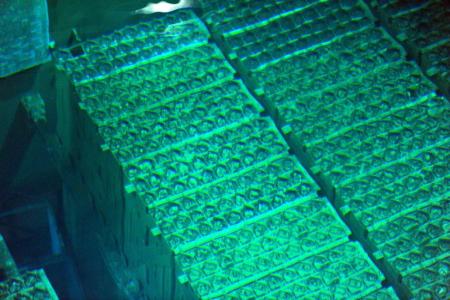The building Fukushima Dai-ichi nuclear power plant, is still unstable, and its spent-fuel storage pool highly dangerous. This month (Nov. 2013) Tokyo Electric Power (TEPCO) will start plucking out over 1,500 radioactive rods from the pool in order to store them more safely. Over the pool a crane waits to start the procedure, and a yellow radiation alarm stands at the ready. Experts call the operation the riskiest stage of the plant’s clean-up so far… Engineers will have to take out each fuel assembly one by one without mishap, and overcome the risks of fire, earthquake and the pool boiling dry. The fuel rods can ignite if they lose coolant, or explode if they collide.
The rods are being moved just when trust in the utility that owns Fukushima Dai-ichi is at a low point. A series of leaks of highly radioactive water this year, and other dangerous accidents including a power cut in March—a rat chewed through the wiring—has brought it under fierce attack. In August the Nuclear Regulation Authority (NRA) said leaks of contaminated water were a level-three or “serious” incident on an international scale that goes up to seven. Now some are calling for the removal of spent-fuel rods from reactor four to be closely monitored by foreign experts.
Even the pro-nuclear ruling Liberal Democratic Party (LDP) wants to take TEPCO in its current form out of the decommissioning process, which will take 40 or more years. A new entity, including the utility’s staff but separate from its commercial side, would take charge. Finding a solution to the problem of TEPCO’s structure (among other things, the company is financially precarious) would help the government’s efforts to switch nuclear power back on.
At the moment Japan is entirely without nuclear energy, but that is unlikely to last for long. Shinzo Abe, the prime minister, is pushing for as many of the country’s 50 usable reactors to restart as soon as possible after passing safety checks by the NRA. The need to import energy has pushed up the price of electricity and added to a series of trade deficits since 2011. In September TEPCO won approval from the governor of Niigata prefecture to apply for a safety check in order to restart two reactors at its Kashiwazaki-Kariwa nuclear plant, the world’s biggest… Junichiro Koizumi, a popular LDP former prime minister, has stepped in, calling for an immediate end to nuclear power. After he broadcast his views at a press conference, a poll showed that three-fifths of those who were surveyed backed his plan.
Japan and nuclear power: High alert, Economist, Nov. 16, 2013, at 47
